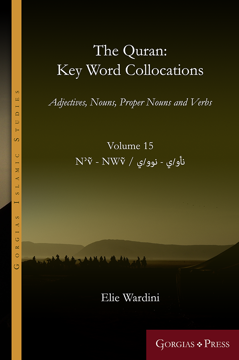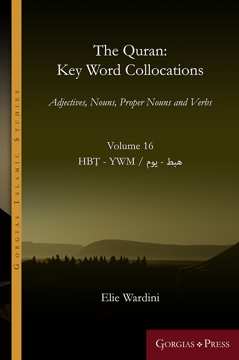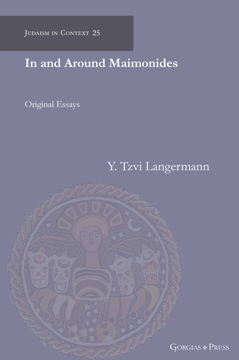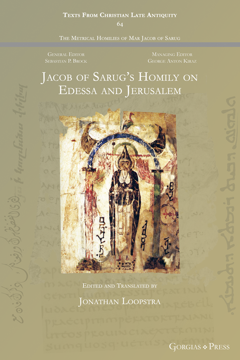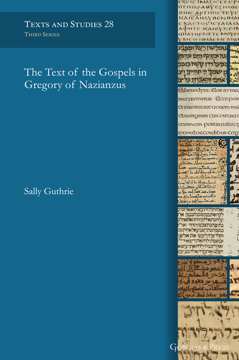Key Word Collocations (Volume 15)
Adjectives, Nouns, Proper Nouns and Verbs
By Elie Wardini
Series: Gorgias Islamic Studies 15
ISBN: 978-1-4632-4325-8
The aim with the present series, The Quran: Key Word Collocations is to present the Quran as raw data with as little interpretation as possible. The digital text used for this purpose is the Uthmani text of the Tanzil Quran Text. In the present series, Collocation is defined as a Key Word, here adjectives, nouns, proper nouns and verbs, forming the center of a cluster with four co-occurring Key Words (1° and 2° of proximity), the first two to the left and to the right, where available. Every Collocation of each Key Word in the Quran is presented in context, as a rule with six words to the right and six to the left of it, where available or where the formatting permits. The central Key Words have been grouped by root > lemma. Classical dictionaries and Quran commentaries, as well as modern Quran dictionaries have been consulted.
$199.00 (USD) $119.40 (USD)
Key Word Collocations (Volume 16)
Adjectives, Nouns, Proper Nouns and Verbs
By Elie Wardini
Series: Gorgias Islamic Studies 15
ISBN: 978-1-4632-4327-2
The aim with the present series, The Quran: Key Word Collocations is to present the Quran as raw data with as little interpretation as possible. The digital text used for this purpose is the Uthmani text of the Tanzil Quran Text. In the present series, Collocation is defined as a Key Word, here adjectives, nouns, proper nouns and verbs, forming the center of a cluster with four co-occurring Key Words (1° and 2° of proximity), the first two to the left and to the right, where available. Every Collocation of each Key Word in the Quran is presented in context, as a rule with six words to the right and six to the left of it, where available or where the formatting permits. The central Key Words have been grouped by root > lemma. Classical dictionaries and Quran commentaries, as well as modern Quran dictionaries have been consulted.
$216.00 (USD) $129.60 (USD)
In and Around Maimonides
Original Essays
Series: Judaism in Context 25
ISBN: 978-1-4632-4330-2
In and Around Maimonides presents eight highly focused studies on Moses Maimonides and those around him.
$110.00 (USD) $66.00 (USD)
The Lord God of Gods
Divinity and Deification in Early Judaism
ISBN: 978-1-4632-4333-3
The investigation of this book into early Jewish experiences of God begins with calls to discard any categorical and definitional approaches to the literature of early Judaism, and several enduring preconceptions about its mysticism and theology (particularly the relegation of its mysticism to particular texts and themes, and the molding of its theology in the image of medieval and post-medieval Jewish and Christian monotheisms). With this abandonment, the symbolic language of early Jewish texts gives sharper contours to a pre-formal theology, a theology in which God and divinity are more subjects of experience and recognition than of propositions. This clarity leads the investigation to the conclusion that early Judaism is thoroughly mystical and experiences a theology which is neither polytheistic, nor monotheistic, but deificational: there is only one divine selfhood, the divinity of “God,” but he shares his selfhood with “gods,” to varying degrees and always at his discretion. With some important differentiations which are also introduced here, this theology undergirds almost the entirety of early Judaism—the Bible, post-biblical texts, and even classical rabbinic literature. The greatest development over time is only that the boundaries between God and gods become at once clearer and less rigid.
$114.95 (USD) $68.97 (USD)
Jacob of Sarug's Homily on Edessa and Jerusalem
Edited and Translated by Jonathan Loopstra
Series: Texts from Christian Late Antiquity 64
ISBN: 978-1-4632-4335-7
Recognized as a saint by both Chalcedonian and non-Chalcedonian Christians alike, Jacob of Sarug (d. 521) produced many narrative poems that have rarely been translated into English. Of his reported 760 metrical homilies, only about half survive. Part of a series of fascicles containing the bilingual Syriac-English editions of Saint Jacob of Sarug’s homilies, this volume contains his homily on Edessa and Jerusalem. The Syriac text is fully vocalized, and the translation is annotated with a commentary and biblical references. The volume is one of the fascicles of Gorgias Press’s Complete Homilies of Saint Jacob of Sarug, which, when complete, will contain all of Jacob’s surviving sermons.
$35.00 (USD) $21.00 (USD)
The Text of the Gospels in Gregory of Nazianzus
Series: Texts and Studies (Third Series) 28
ISBN: 978-1-4632-4337-1
Quotations in early Christian writers provide important evidence for the text of the New Testament as well as the ways in which Scripture was used and received in the early Church. The fourth-century archbishop Gregory of Nazianzus was one of the most influential and widely-read authors of his time, but because the majority of his output was in poetic form he has rarely been treated as a source for the biblical text. The present study brings together all the identifiable references to the Gospels in Gregory’s writings for the first time, comparing them with standard biblical texts and manuscripts in order to determine their significance for the history and transmission of the New Testament. This collection also sheds new light on Gregory’s treatment of Scripture and the distinctive role it plays in his rhetorical style.
$149.00 (USD) $89.40 (USD)
